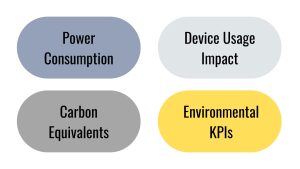Sustainable Movement: Green Software Development
Introduction The global push for sustainability has impacted nearly every industry, and the tech sector, known for its rapid growth and energy consumption, is no exception. Su...

Introduction
The global push for sustainability has impacted nearly every industry, and the tech sector, known for its rapid growth and energy consumption, is no exception. Sustainable software development, part of the broader green IT movement, focuses on reducing the environmental impact of software throughout its lifecycle. This movement is driven by the desire to create software solutions that are both technically efficient and environmentally responsible.
Here’s a deep dive into green software development that companies can use.
Understanding Green Software Development
Green software development aims to reduce the environmental footprint of software products and services. It focuses on optimising energy consumption, minimising resource use, and increasing software efficiency without compromising performance. Sustainable software practices not only reduce emissions and save energy, but also reduce costs, improve productivity, and promote brand loyalty by attracting environmentally conscious consumers.
Key Components of Green Software Development
- Energy Efficiency: Reducing software energy consumption is a key goal of sustainable development. This involves creating software that minimises CPU, memory, and storage usage to reduce the energy required to run applications.
- Sustainable Software Design: Designing for efficiency and resource management from the start can have a long-term impact. This includes choosing appropriate architectures and algorithms and selecting frameworks with low resource consumption.
- Waste Reduction: This involves reducing digital waste such as redundant code or unused data storage. An optimised code base and effective data management reduce both operating costs and environmental impact.

Green Software Development Practices
- Optimising code efficiency: Optimised code reduces the load on servers and devices, resulting in lower energy consumption. Techniques such as optimising algorithms, reducing code complexity, and minimising redundancy help make software more efficient.
- Using efficient programming languages: Different languages consume different amounts of energy. For example, studies show that languages such as C and Rust are more energy efficient than languages such as Python and Ruby. Choosing efficient languages for specific tasks can help create greener software.
- Implementing sustainable architecture patterns: Architectural decisions such as microservices instead of monolithic architectures allow applications to scale out portions of the service when they are not in use, saving energy. Additionally, architectures based on edge computing help reduce the need for data transmission by processing data closer to the user, reducing network energy consumption.
- Resource management: Allocating resources only when needed, rather than allowing idle resources to consume energy, is critical. Techniques such as virtualisation, containerisation, and on-demand scaling in cloud computing can help reduce idle power consumption.
- Server-side optimisation: Efficient server utilisation can significantly reduce power consumption. Techniques such as load balancing, server clustering, and containerization can help make server utilisation more efficient.
Adopting Cloud Computing for Green Software Development
Cloud providers are increasingly offering services optimised for sustainability, including low-energy data centres and zero-carbon infrastructure. Sustainable cloud practices include:
- Choosing green cloud providers: Major providers like AWS, Google Cloud, and Microsoft Azure have made strides in energy efficiency and renewable energy use. By choosing a cloud provider with green credentials, companies can reduce the environmental impact of their software.
- Serverless architecture: This approach allows the cloud provider to manage scaling, which saves resources by allocating only what is needed, when it is needed.
- Data centre efficiency: Choose cloud services that run in energy-efficient data centres. Look for providers that participate in initiatives like renewable energy credits (RECs) and carbon offsets.

Data Management Strategies for Sustainability
Data storage is one of the largest energy consumers in software development, so data management strategies are critical:
- Data minimisation: Storing only the data that is needed, implementing strict data retention policies, and removing redundant data reduces storage needs and therefore energy consumption.
- Compression and deduplication: Techniques such as data compression reduce the size of data files, while deduplication prevents duplicate data from being stored.
- Efficient data processing: Instead of using high-power servers to continuously process data, many applications can use batch processing or scheduled data processing during off-peak hours, which requires less energy.
Building User Awareness and Sustainable Usage Habits
User habits can influence the environmental impact of software. Educating users about sustainable use can expand the benefits of green software development:
- Dark mode and power-saving options: Offering dark mode or power-saving modes in apps can reduce the power consumption of displays, especially on devices with OLED screens.
- Data usage awareness: Keeping users informed about their data consumption (such as streaming quality settings) helps them make choices that save data and energy.
- Managing software updates: Frequent, incremental updates can minimise large data downloads and spikes in server usage, reducing energy consumption.

Ethical and Sustainable Software Lifecycle Management
The concept of sustainability should cover the entire software lifecycle, from development to deployment and end-of-life management:
- Development and testing: Green testing practices, such as virtualization for testing multiple devices or using energy-efficient development environments, reduce the environmental impact at this stage.
- Deployment: Efficient deployment practices, such as CI/CD pipelines that optimise resources and avoid redundant builds, contribute to sustainability.
- End-of-life management: When software reaches the end of its life, it is important to have an environmentally friendly disposal plan. Consider sustainable migration strategies that can reuse data and processes or archive data with minimal energy storage solutions.
Measuring Green Metrics in Software Development
Green software development relies on metrics to track and optimise environmental impact. Examples of green software metrics include:
- Power Consumption: Track software energy consumption on both the server and client sides to identify areas for optimisation.
- Carbon Equivalents: Measure the carbon equivalent of energy used in software operations to quantify environmental impact.
- Device Usage Impact: Understanding how software impacts device resource consumption, such as battery life and CPU usage, can provide insights for further optimisation.
- Environmental KPIs: Set key performance indicators related to energy efficiency, waste reduction, and emissions targets to measure the effectiveness of sustainable practices.

Future of Sustainable Software Development
Green software development is gaining momentum as technology and sustainability efforts advance. Emerging trends include the rise of green blockchain applications, sustainable AI, and software solutions designed to be recycled and reused.
- Blockchain and Energy Efficiency: Blockchain is known for its high energy consumption, but new protocols and innovations like Proof of Stake are significantly reducing energy consumption.
- AI and Machine Learning: With increasing demands on machine learning data, energy-efficient algorithms, optimised model training, and inference methods are becoming essential.
- Green DevOps: Sustainable DevOps emphasises efficient deployment cycles, monitoring, and scaling techniques that optimise server and resource usage.
Conclusion
Sustainable software movement highlights the role of the tech industry in shaping a greener future. By implementing sustainable practices at every stage of the software lifecycle, from design and development to deployment and maintenance, companies can contribute to global efforts to protect the environment while creating high-performing, efficient applications. As awareness of the importance of green practices grows, adopting sustainable software development will be essential not only for environmental responsibility, but also for remaining competitive and relevant in an increasingly sustainability-focused marketplace.
Sustainable software is more than a trend; it is a movement shaping the future of development for a healthier planet and a stronger industry.